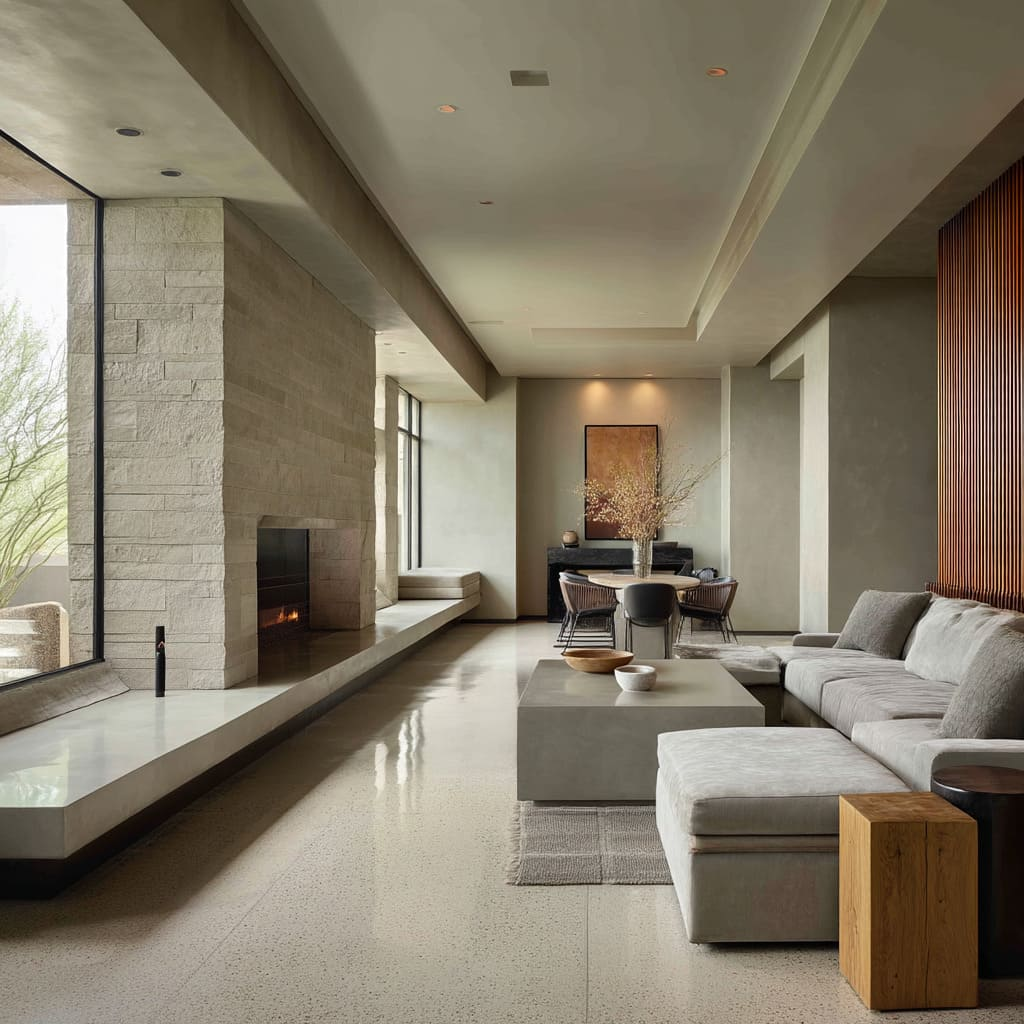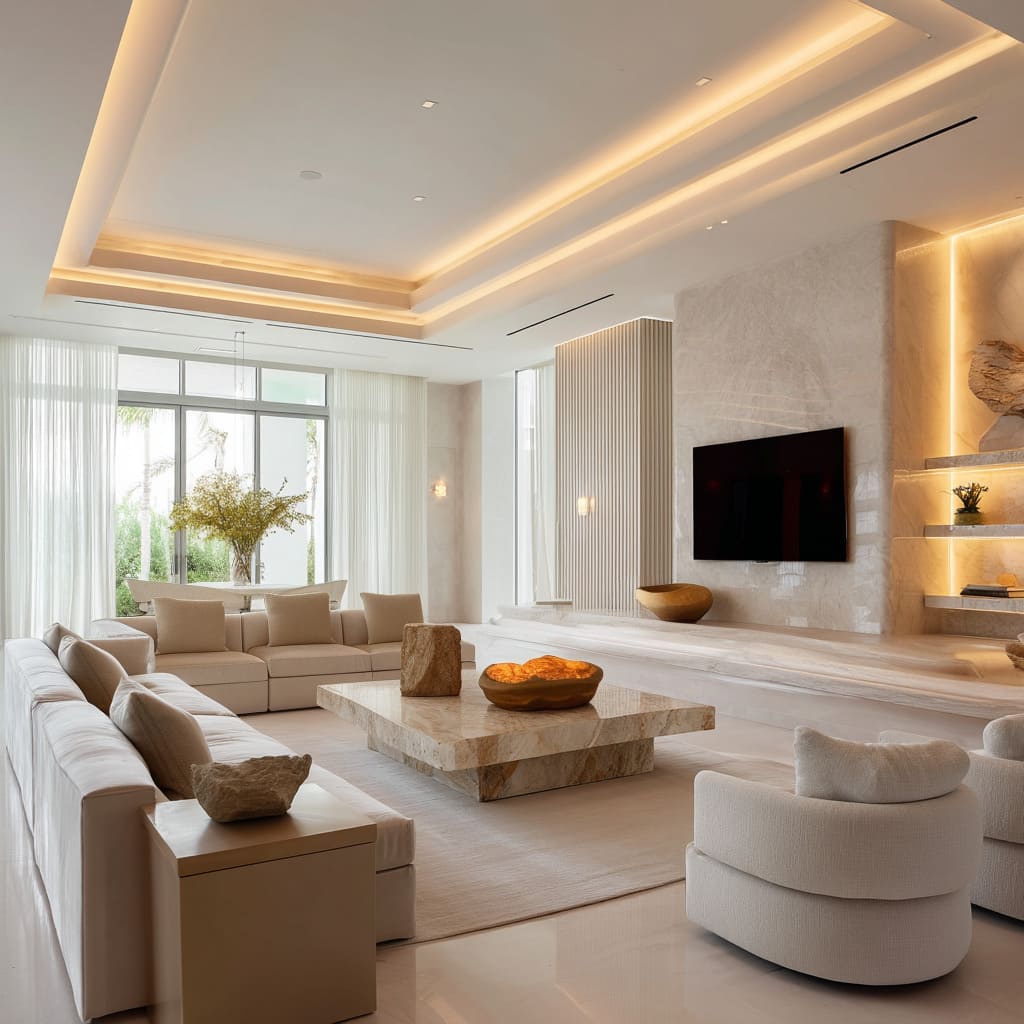Luxury in contemporary living rooms is no longer about being flashy; it’s all about the subtle choices that may go unnoticed at first glance. What sets modern spaces apart is the level of clarity and coordination that doesn’t rely on bold statement pieces. Lighting is strategically placed, materials are thoughtfully chosen and repeated with purpose, and layouts are carefully planned to ensure each element works together seamlessly without overpowering. These rooms don’t compete with the outdoors; instead, they invite nature inside.

Glass walls glide open, floors extend beyond the threshold, and ceiling lines carry a gentle rhythm from one space to the next.
This guide explores the patterns behind such rooms—the subtle choices that create comfort, quiet drama, and cohesion. From lighting strategies to material flow and furniture that feels built into the architecture, we’ll reveal how each detail works in harmony.
Whether you’re updating your own space or studying the latest shifts in luxury interiors, this is your lens into why precision, flow, and understated contrast define refined living today.

The Art of Hidden Design: Creating Atmosphere with Integrated Lighting

In many contemporary luxury living rooms, lighting shapes the space without drawing attention. Instead of chandeliers or visible fixtures, it’s tucked into ceiling coves, hidden behind paneling, or tracing the edges of niches—keeping surfaces clean and the focus on form and texture.
A hallmark of modern design is tuning indoor light to echo daylight’s character. Using LEDs that shift tone with the sun’s rhythm, designers create a seamless transition between indoors and outdoors, especially in rooms with expansive glass walls

Layering light in a luxury living room is subtle, but it’s everything. A soft glow might graze the ceiling edge, another warm strip could sit quietly behind the shelves, and a faint line might rest beneath the hearth.
You don’t really notice these layers until dusk or early morning, when they shift gently in tone to hold the mood just right. It’s less about spotlighting a feature and more about creating depth through softness.
In the end, it’s this quiet lighting plan that gives the room its structure. It shapes the atmosphere, enriches textures, and lets the materials speak. The system stays invisible, but it’s doing all the real work.
Seamless Living: How Open Transitions Create Multi-Zone Spaces

In luxury homes today, open layouts have evolved past the idea of one vast, uninterrupted room. What makes contemporary living rooms feel so inviting is the way they handle flow—how spaces open into each other effortlessly, yet still offer their own moments for lounging, gathering, or curling up with a book.
A favorite design move is the use of full-height glass doors that slide away completely into hidden wall pockets. Unlike standard sliders, these walls disappear entirely, leaving nothing between you and the view.
In warmer climates, this creates a true indoor-outdoor lifestyle year-round. In cooler regions, the same spirit shows up through oversized windows and layouts that pull in as much light and landscape as possible.

Some layouts use vertical shifts to guide flow. Instead of adding partitions, designers create subtle changes in floor height.
Stepping down into a lounge area signals a sense of arrival without blocking the view. These sunken spaces often have deep, inviting sofas, softer lighting, and extra acoustic insulation—forming a cozy cocoon that still feels connected to the rest of the room.
The magic lies in the alignment: ceiling lines, furniture placement, and rug boundaries all working together. No walls, no dividers—just precise, well-measured changes that define each zone with intention, while keeping the space whole.
The Art of Neutrals: Creating Richness Through Texture

Neutral doesn’t mean plain—it means purposeful. In many luxury modern living rooms, color takes a backseat so texture can take center stage.
You’ll often find spaces rooted in a soft palette of warm whites, gentle taupes, or pale gray-beiges. The interest comes not from bold colors, but from the feel of each surface.
A boucle sofa next to brushed linen drapes doesn’t feel repetitive—it feels thoughtfully layered. Then there’s the smooth, cool touch of honed limestone on the fireplace, or a matte oak floor with just enough grain to catch the afternoon light.
Here, contrast is about texture, not hue, creating a quiet richness that invites you in.

The Power of Form: Sculptural Furniture in Contemporary Interiors

One of the most defining features of a luxury modern living room is how the furniture shapes the space. Today’s designs don’t just place furniture—they sculpt it.
More often than not, that means curves. While the room might be built around straight lines—think ceiling beams, sharp stone hearths, or tall window frames—the furniture pushes back with soft, rounded forms.
Curved sectionals, circular ottomans, and arch-backed chairs break the rigidity, adding flow and movement to the room.
It’s this play between crisp architecture and gentle curves that keeps the space feeling dynamic, alive, and welcoming.

A growing trend in luxury living rooms is moving away from one large sectional toward conversation circles—like armchairs or curved sofas arranged to encourage connection.
Built-in or floating seating, such as legless platform sofas or curved benches, further blend furniture with architecture. These pieces keep sightlines open and highlight the room’s shape without adding bulk.
This subtle approach lets modern luxury furniture shine by balancing comfort, flow, and rhythm throughout the space.
Open Concept Living: Subtle Ways to Define Zones Without Walls

Many contemporary luxury living rooms skip walls to define their spaces. Instead, they use subtle shifts in materials, lighting, and alignment to create flow.
One of the simplest yet most effective tools is the rug. A large, woven rug—often in jute, wool, or a soft blend—grounds the seating area without loud patterns.
Its muted tone gently contrasts with the floor, marking a clear but soft boundary for conversation and lounging.

The ceiling plays a key role too. Coffered or recessed designs often mirror the furniture layout, anchoring the space without walls—perfect for open-concept homes.
Built-ins quietly divide rooms, with seamless cabinetry and flush shelves that both define zones and keep sightlines open.
These subtle touches let you move freely through the space while maintaining clear, intentional boundaries—making the design feel effortless and thoughtful.
How Fireplaces Anchor Contemporary Living Room Design

Today’s luxury interiors put fireplaces front and center. Whether wide and low or tall and striking, they often set the tone for the entire room’s layout.
A popular style is the extended fire ribbon—long, linear, and quietly dramatic. It might sit beneath a broad stone slab or be built into a sleek concrete bench.
These horizontal designs pair perfectly with wide sectionals and open layouts, grounding the space without adding clutter.

Some designs enhance fireplaces with floating hearths—recessed bases lit softly from below to create a sense of lightness without losing impact.
In rooms with double-height ceilings, fireplaces often extend upward, featuring materials like ribbed stone or matte steel that catch light and transform the wall into a sculptural element.
These fireplaces anchor the room seamlessly, integrated into the architecture to provide presence without overpowering the space.
Mastering Ultra-Refined Architectural Framing in Luxury Spaces

One of today’s key marks of luxury design is what’s left out. Instead of adding layers, these spaces reduce visual noise to feel effortless.
In many contemporary living rooms, the absence of trim, bulky vents, or heavy fixtures creates a clean, seamless look. Window and door frames, for example, flow directly into the walls without thick moldings.
This sharp alignment lets openings stand on their own—clean and uninterrupted—bringing a calm rhythm and blurring the line between indoors and out.

This minimalist approach extends to all the details. Air vents tuck invisibly into panels or recessed slots near the ceiling. Outlets, switches, and door hinges disappear into walls, keeping surfaces calm and distraction-free.
Ceilings follow suit. Coffered beams are broad and simple—no carvings or moldings—focusing instead on scale and shadow to add depth without drawing attention.
This disciplined framing takes careful planning, but the result is a space that feels grounded, intentional, and effortlessly refined.
How Art and Objects Create Calm Statements in Contemporary Living Rooms

In luxury interiors, accessories don’t demand attention—they quietly enhance the space. Restraint is key.
A single large artwork, a few ceramics, or a carefully chosen sculpture often does the job. The goal isn’t to fill every shelf or wall but to let each piece breathe.
Most objects are chosen for their shape and texture rather than showiness—think raw-edged stone bowls, rough-finished vases, or wooden forms that echo the room’s materials.
These pieces aren’t just decoration—they’re part of the overall material story, creating a seamless flow between furnishings and accessories.

Lighting plays a quiet but powerful role. Rather than bright overhead spots, designers often choose integrated strips behind shelves or tiny recessed LEDs above artwork.
This soft, directional light highlights pieces without stealing the show. It adds depth, enhances texture, and helps the art feel woven into the room rather than simply placed.
What makes this approach work is its subtlety. In the best spaces, art becomes just another material—like stone or wood—that shapes the overall mood.
Seamless Flow: Continuity in Ceiling and Floor Patterns in Luxury Interiorsb

In cohesive luxury homes, ceiling beams and floorboards align to create a quiet, guiding rhythm through the space. Material transitions are thoughtfully placed at natural breaks, enhancing flow without distraction. Subtle ceiling details with hidden lighting balance room weight, making even large spaces feel light and connected.
Balancing Classic and Modern Design: Timeless Luxury Interiors

The best interiors blend classic and modern influences with subtle nods—like soft arches or simplified coffered ceilings—without copying the past. Traditional forms meet minimal finishes and natural materials for a fresh, balanced look. This creates spaces that feel both familiar and effortlessly current.
Achieving Material Harmony for Cohesive Contemporary Design

In truly unified homes, material repetition quietly ties everything together. The stone around a fireplace might reappear on a coffee table, or wood slats on a wall echoed in a hallway ceiling. These subtle connections create a rhythmic flow that anchors the entire space.

In the best layouts, furniture goes beyond matching materials—it becomes part of the architecture. A sofa might rest on a base of the same stone as the floor, or a bench appear carved from the room itself. This seamless material echo creates a space that feels thoughtfully unified, yet effortlessly relaxed.
In Conclusion
In contemporary luxury living rooms, true elegance lies in subtlety and intention. Through precise material choices, seamless flow, and thoughtful details—from lighting to furniture—these spaces create a calm, cohesive atmosphere that feels both refined and welcoming. It’s a design philosophy where less truly is more, and every element works quietly together to elevate the whole.

